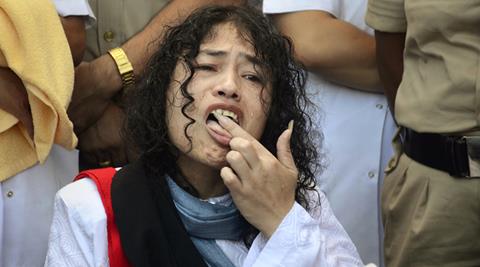Opinion In a new form
As Irom Sharmila ends her fast, begins a different journey, her critique of AFSPA will deepen the political debate.
 Indian political activist Irom Sharmila licks honey from her hand to break her fast in Imphal, north-eastern Indian state of Manipur, India, Tuesday, Aug. 9, 2016. One of India's most prominent political activists ended a 16-year hunger strike Tuesday, licking honey from her hand and declaring "I will never forget this moment." Sharmila had been force-fed through a tube in her nose and held by police since November 2000, when she began her fast to protest a draconian security law that gives immense power to security forces in the northeastern state of Manipur. (AP Photo/Anupam Nath)
Indian political activist Irom Sharmila licks honey from her hand to break her fast in Imphal, north-eastern Indian state of Manipur, India, Tuesday, Aug. 9, 2016. One of India's most prominent political activists ended a 16-year hunger strike Tuesday, licking honey from her hand and declaring "I will never forget this moment." Sharmila had been force-fed through a tube in her nose and held by police since November 2000, when she began her fast to protest a draconian security law that gives immense power to security forces in the northeastern state of Manipur. (AP Photo/Anupam Nath) Sixteen years ago, Irom Sharmila announced that she would have solid food only after the Armed Forces Special Powers Act (AFSPA) is repealed from Manipur. She ended her fast on Tuesday, and the AFSPA continues to be in force in large parts of the state. But for Sharmila, this is not a battle lost. She has promised to continue the fight against the AFSPA but from a new platform — of electoral democracy. Her struggle all these years has focused on the AFSPA, but on Tuesday she hinted at broadbasing it to include larger issues of social and political transformation. She spoke of the right of Kashmiris and Manipuris to self-determination. At the same time, her choice, she made it clear, was to enter and engage with the political democracy secured by the Indian Constitution, to explore and expand its spaces. Her statement that if politics is dirty, so is society, indicates a grounded, non-aesthetisised approach to political activism.
Sharmila, with her steely determination, has come to represent a paradigm of political action that stood apart from the standard practices of collective protests.
Her hunger strike was the struggle of an individual, disempowered by the state and its juridical apparatus, to regain agency. Gandhi had invented the satyagraha as a moral weapon of the powerless against the powerful. The Indian state, which claims to be a legatee of Gandhi, didn’t respond. When its attempt to ignore the strike failed against the persistence of Sharmila, it sought to imprison her in a legal web. Its reaction to Anna Hazare, when he sat on a fast in Delhi, stands in radical contrast. Perhaps the remoteness of Manipur from Delhi, plain insensitivity to the concerns of a proud people in the frontier or discomfort with her critique of the army’s conduct prevented the political class from responding to Sharmila. But Sharmila and the Meira Peibis of Manipur found allies in civil society and their sustained protest has been the biggest challenge to the AFSPA, triggering a national debate over the act and inviting the judiciary’s intervention.
At the same time, it can also be said that Sharmila’s satyagraha exposed the limitations of an individualised form of protest against a powerful state — Gandhi, her inspiration, had built a powerful mass organisation that mobilised people on his behalf when he waged his battles against the British Empire. But the issues Sharmila has flagged have become a part of the national conversation. Her critique of the state and its coercive instruments will continue to be valuable in any discussion about the idea of India.





